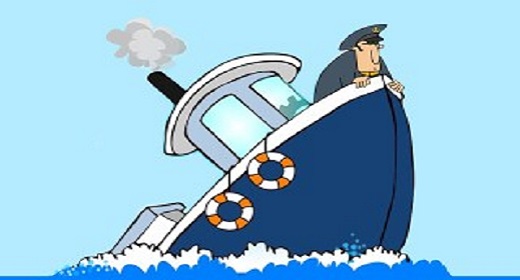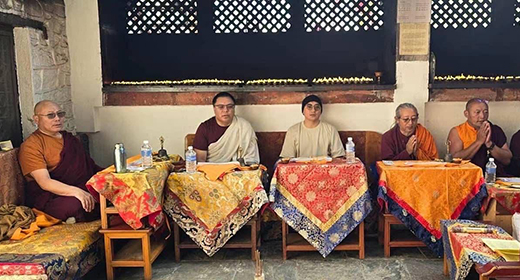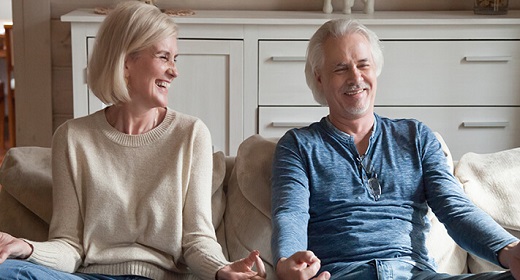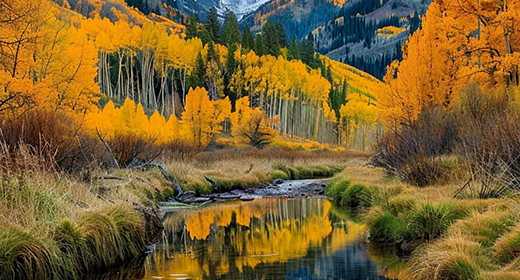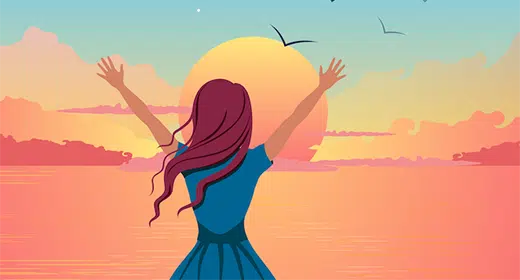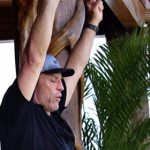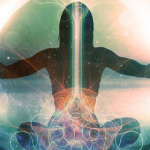by Joan Halifax: Buddhist teacher Joan Halifax describes five “edge states” where courage meets fear and freedom meets suffering…
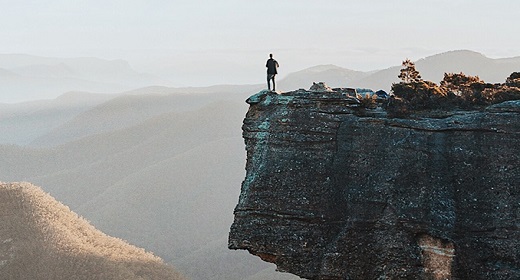
I have a small cabin in the mountains of New Mexico where I spend time whenever I can. It is located in a deep valley in the heart of the Sangre de Cristo Range. It’s a strenuous hike from my cabin up to the ridge at more than twelve thousand feet above sea level, from where I can see the deep cut of the Rio Grande, the run of the ancient Valles Caldera volcano, and the distinctive mesa of Pedernal, where the Diné say First Man and First Woman were born.
Whenever I walk the ridge, I find myself thinking about edges. There are places along the ridgeline where I must be especially careful of my footing. To the west is a precipitous decline of talus leading to the lush and narrow watershed of the San Leonardo River; to the east, a steep, rocky descent toward the thick forest lining the Trampas River. I am aware that on the ridge, one wrong step could change my life. From this ridge, I can see that below and in the distance is a landscape licked by fire and swaths of trees dying from too little sun. These damaged habitats meet healthy sections of forest in borders that are sharp in places, wide in others. I have heard that things grow from their edges. For example, ecosystems expand from their borders, where they tend to host a greater diversity of life.
Edges are places where opposites meet. Where fear meets courage and suffering meets freedom.
My cabin sits on the boundary between a wetland fed by deep winter snow and a thick spruce-fir forest that has not seen fire in a hundred years. Along this boundary is an abundance of life, including white-barked aspen, wild violet, and purple columbine, as well as the bold Steller’s jay, the boreal owl, ptarmigan, and wild turkey. The tall wetland grasses and sedges of summer shelter field mice, pack rats, and blind voles that are prey for raptors and bobcats. The grasses also feed the elk and deer who graze in the meadows at dawn and dusk. Juicy raspberries, tiny wild strawberries, and tasty purple whortleberries cover the slopes holding our valley, and the bears and I binge shamelessly on their bounty come late July.
I have come to see that mental states are also ecosystems. These sometimes friendly and at times hazardous terrains are natural environments embedded in the greater system of our character. I believe it is important to study our inner ecology so that we can recognize when we are on the edge, in danger of slipping from health into pathology. And when we do fall into the less habitable regions of our minds, we can learn from these dangerous territories. Edges are places where opposites meet. Where fear meets courage and suffering meets freedom. Where solid ground ends in a cliff face. Where we can gain a view that takes in so much more of our world. And where we need to maintain great awareness, lest we trip and fall.
Our journey through life is one of peril and possibility—and sometimes both at once. How can we stand on the threshold between suffering and freedom and remain informed by both worlds? With our penchant for dualities, humans tend to identify either with the terrible truth of suffering or with freedom from suffering. But I believe that excluding any part of the larger landscape of our lives reduces the territory of our understanding.
Life has taken me into geographically, emotionally, and socially complex geographies. Organizing within the Civil Rights and antiwar movements of the sixties, working in a big county hospital as a medical anthropologist, founding and leading two practice and educational communities, sitting at the bedside of dying people, volunteering in a maximum-security prison, meditating for extended periods, collaborating with neuroscientists and social psychologists on compassion-based projects, and running health clinics in the remotest areas of the Himalayas—all have introduced me to complex challenges, including periods of overwhelm. The education I’ve gained through these experiences—especially through my struggles and failures—has given me a perspective I could never have anticipated. I have come to see the profound value of taking in the whole landscape of life and not rejecting or denying what we are given. I have also learned that our waywardness, difficulties, and “crises” might not be terminal obstacles. They can actually be gateways to wider, richer internal and external landscapes. If we willingly investigate our difficulties, we can fold them into a view of reality that is more courageous, inclusive, emergent, and wise—as have many others who have fallen over the edge.
Edge States
Over the years, I slowly became aware of five internal and interpersonal qualities that are keys to a compassionate and courageous life, and without which we cannot serve, nor can we survive. Yet if these precious resources deteriorate, they can manifest as dangerous landscapes that cause harm. I called these bivalent qualities Edge States.
We can lose our firm footing on the high edge of any of these qualities and slide into a mire of suffering.
The Edge States are altruism, empathy, integrity, respect, and engagement, assets of a mind and heart that exemplify caring, connection, virtue, and strength. Yet we can also lose our firm footing on the high edge of any of these qualities and slide into a mire of suffering where we find ourselves caught in the toxic and chaotic waters of the harmful aspects of an Edge State.
Altruism can turn into pathological altruism. Selfless actions in service to others are essential to the well-being of society and the natural world. But sometimes, our seemingly altruistic acts harm us, harm those whom we are trying to serve, or harm the institutions we serve in.
m>Empathy can slide into empathic distress. When we are able to sense into the suffering of another person, empathy brings us closer to one another, can inspire us to serve, and expands our understanding of the world. But if we take on too much of the suffering of another, and identify too intensely with it, we may become damaged and unable to act.
Integrity points to having strong moral principles. But when we engage in or witness acts that violate our sense of integrity, justice, or beneficence, moral suffering can be the outcome.
Respect is a way we hold beings and things in high regard. Respect can disappear into the swamp of toxic disrespect, when we go against the grain of values and principles of civility, and disparage others or ourselves.
Engagement in our work can give a sense of purpose and meaning to our lives, particularly if our work serves others. But overwork, a poisonous workplace, and the experience of the lack of efficacy can lead to burnout, which can cause physical and psychological collapse.
Even in their degraded forms, Edge States can teach and strengthen us, just as bone and muscle are strengthened when exposed to stress, or if broken or torn, can heal in the right circumstances and become stronger for having been injured.
The way back to freedom on the high edge of strength and courage, is through the power of compassion.
In other words, losing our footing and sliding down the slope of harm need not be a terminal catastrophe. There is humility, perspective, and wisdom that can be gained from our greatest difficulties. In her book The Sovereignty of Good (1970), Iris Murdoch defined humility as a “selfless respect for reality.” She writes that “our picture of ourselves has become too grand.” This I discovered from sitting at the bedside of dying people and being with caregivers. Doing this close work with those who were dying and those who were giving care showed me how serious the costs of suffering can be for patient as well as caregiver. Since that time, I have learned from teachers, lawyers, CEOs, human rights workers, and parents that they can experience the same. I was then reminded of something profoundly important and yet completely obvious: that the way out of the storm and mud of suffering, the way back to freedom on the high edge of strength and courage, is through the power of compassion.
Futility and Courage
I have a friend who was a dedicated and skillful psychologist, but after years of practicing, he had caved in to futility. In a conversation with me, he confessed, “I just can’t bear to listen to my patients anymore.” He explained that at a certain point in his career, he had begun to feel every emotion his patients were going through, and he was totally overwhelmed by their experiences of suffering. The constant exposure had eventually dried him up. At one point, he couldn’t sleep, and was overeating to relieve stress. Gradually he had moved into a space of helplessness and emotional shutdown. “I just don’t care,” he said. “I feel flat and gray inside.” Worst of all, he had begun to resent his clients, and he knew this meant he needed to get out of his profession.
His story exemplifies the negative outcomes of a combination of all the Edge States: what happens when altruism goes toxic, empathy leads to empathetic distress, respect collapses under the weight of sensitivity and futility and turns to disrespect with a loss of integrity, and engagement leads to burnout. Suffering had crept up on the psychologist, and he began to die inside. He could no longer absorb and transform pain to find meaning in his work and his world.
My friend is far from alone in his suffering. Many caregivers, parents, and teachers have confided similar feelings to me. Part of my work has been to address the devastating epidemic of futility, which leads to a deficit of compassion in people who are expected to care.
I have another friend, a young Nepali woman who bucked the odds and turned adversity into strength. Pasang Lhamu Sherpa Akita, one of the country’s greatest woman mountain climbers, was an hour’s walk from Everest Base Camp in April 2015 when the 7.8 earthquake hit. She heard the thundering avalanche that killed many at Base Camp. She immediately set off to help but was forced to turn back when an aftershock hit.
Pasang’s home in Kathmandu had been destroyed by the quake—but she and her husband, Tora Akita, realized that they had to respond to the loss of life, home, and livelihood that many in Nepal were facing. “I could have been killed at Everest Base Camp,” Pasang said. “But I was safe. I survived. There had to be some reason why I survived. I told my husband, ‘We have to do something for the people who are in trouble.’”
In Kathmandu, Pasang and Tora began to organize young people, and hired trucks to bring rice, lentils, oil, salt, and tarps to people in Sindhupalchowk, the region of the quake’s epicenter. She returned week after week to the Gorkha area with roof tin, tents, medicine, and more tarps for the survivors in a number of villages. She hired local people to make new trails across and over landslides that had destroyed existing pathways. She employed hundreds of villagers to bring food and supplies to people who were completely isolated by the effects of the quake and facing the monsoon season without food or shelter.
We can draw lessons from places of utter devastation.
Pasang was acting from altruism, an Edge State that can easily enough tip toward harm. But in speaking with Pasang during her months of intensive service following the earthquake, I never detected anything in her voice but unlimited goodwill energy, and dedication. She also expressed a tremendous sense of relief that she and her husband were able to help.
My psychologist friend went over the edge and never found his way back. My Nepali friend stood on the edge of her humanity. How is it that some people don’t get beaten down by the world but are animated by the deep desire to serve?
I think compassion is key. The psychologist had lost his connection to his compassionate heart; burnout had deadened his feelings. Cynicism had sent down a deep root. Pasang, though, was able to remain grounded in compassion and let those feelings guide her actions. I have come to view compassion as the way to stand grounded and firm on the precipice and not fall over the edge. And when we do fall over the edge, compassion can be our way out of the swamp.
When we learn to recognize the Edge States in our lives, we can stand on the threshold of change and see a landscape abundant with wisdom, tenderness, and basic human kindness. At the same time, we can see a desolate terrain of violence, failure, and futility. Having the strength to stand at the edge, we can draw lessons from places of utter devastation—the charnel grounds—of refugee camps, earthquake-destroyed areas, prisons, cancer wards, homeless encampments, and war zones, and at the same time be resourced by our basic goodness and the basic goodness of others. This is the very premise of coming to know intimately the Edge States: How we develop the strength to stand at the edge and have a wider view, a view that includes all sides of the equation of life. How we find life-giving balance between oppositional forces. How we find freedom at the edge. And how we discover that the alchemy of suffering and compassion brings forth the gold of our character, the gold of our hearts.



